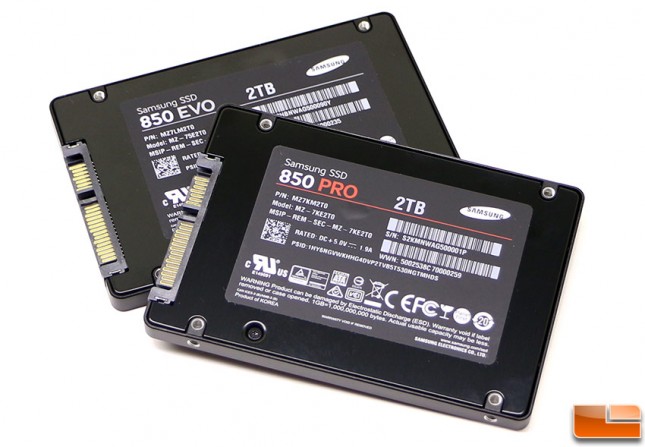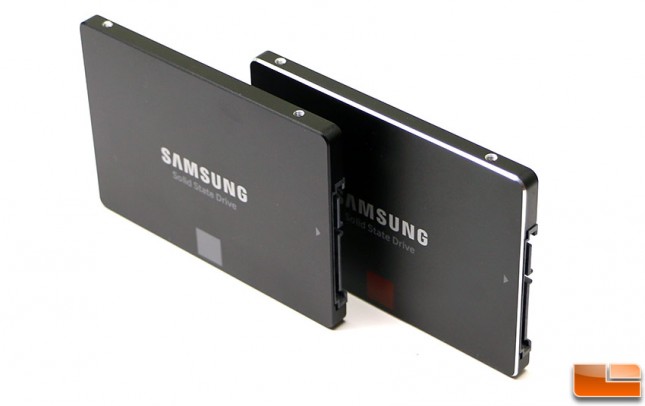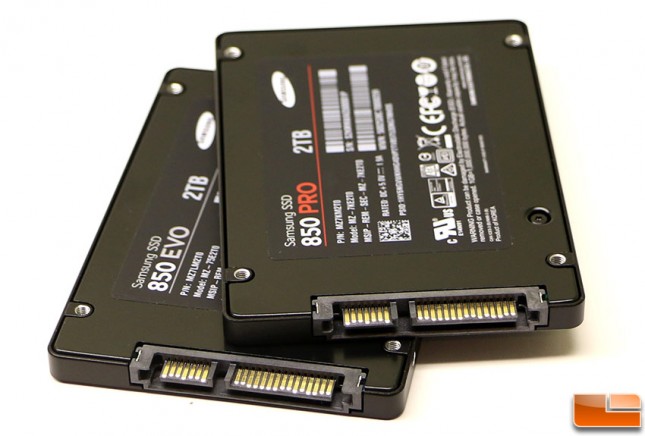Samsung 850 PRO 2TB SSD Vs Samsung 850 EVO 2TB SSD
SSD Review: 850 EVO Versus 850 PRO
For the past decade weve been hearing people say that it was only a matter of time before Solid-State Drives (SSD’s) will nearly completely kill off magnetic drives. Traditional hard drives will still exist in niche markets they said, but SSDs will eventually reign supreme with regards to performance, cost, form factor size and capacity. Any PC enthusiast that has built a system in recent years knows that SSDs have already won the performance and form factor battle, but they are still lacking in storage capacity and cost. The $/GB argument is very subjective, but it appears that many are wanting to purchase flagship SSDs well below the $0.50 mark when it comes to cost per GB.
Samsung has raised the bar with regards to storage capacity in its SSDs today by releasing massive new 2TB models in the 850 PRO and 850 EVO product lines. These are Samsungs highest-capacity SSDs to date for the consumer market and they are being released now because Samsung feels the market and pricing will finally support large 2TB SSDs. Samsungs previous highest-capacity SSD could hold just 1TB of data, so Samsung has doubled the storage capacity of their consumer SSD product line! Both of the 2TB drives are also priced below $0.50 per GB!
These drives are just a capacity increase for the existing Samsung 850 PRO and 850 EVO series, so there isn’t too much new to talk about under the hood as the amount of NAND is the only thing of significance to change. We already did reviews on the Samsung 850 Pro 1TB and Samsung 850 EVO 120GB and 500GB drives when those series first were launched, so we’ll let you go back and read those if you’d like all the background information on each series.
| 850 PRO 2TB | 850 EVO 2TB | |
| Model Number | MZ7KM2T0 | MZ75E2T0 |
| Samsung Controller | MHX | MHX |
| Samsung 3D V-NAND | 2bit MLC | 3bit TLC |
| Cache | 2GB | 2GB |
| Seq. Read | 550 MB/s | 540 MB/s |
| Seq. Write | 520 MB/s | 520 MB/s |
| 4K Random Read QD1 | 10,000 IOPS | 10,000 IOPS |
| 4K Random Write QD1 | 36,000 IOPS | 40,000 IOPS |
| 4K Random Read QD32 | 100,000 IOPS | 98,000 IOPS |
| 4K Random Write QD32 | 90,000 IOPS | 90,000 IOPS |
| Idle Power | 60mW | 60mW |
| Max Read/Write Power | 3.3W / 3.4W | 3.7W / 4.7W |
| MTBF | 2 Million Hours | 1.5 Million Hours |
| TB Written (TBW) | 300 TBW | 150 TBW |
| GB/day | 80GB | 80GB |
| Warranty | 10 years | 5 Years |
Both drives use Samsungs newest MHX controller along with the latest 3D V-NAND technology, in which storage chips are placed on top of each other. By utilizing 3D V-NAND you can get up to 50% power savings over 2D planar NAND and do so in a smaller package! The Samsung’s 3D V-NAND is stacked 32 cell layers vertically over one another and the storage chips are connected through a thin, high-speed connector called TSV (Thru Silicon Via). The big difference between these drives is that Samsung is using 2bit MLC on the 850 PRO and 3bit TLC on the 850EVO. As their names imply, 2-bit MLC NAND stores 2 bits of data per cell and 3-bit TLC NAND stores 3 bits of data per cell. 3-bit TLC NAND-based products have started to dominate the SSD industry since they chips are less costly to produce, but the generally have lower performance and endurance ratings. This is one of the reasons for the cost and warranty difference between the 850 Pro and 850 EVO as the 850 Pro is using what many would argue is better NAND. Many will say that 2-bit MLC NAND far exceeds the needs for consumer SSDs, but we’ve had our fair share of SSDs die here over the years and we are big fans of endurance and reliability after having numerous failures.
When it comes to performance the 850 EVO 2TB SSDs sequential read speed is 540 MB/s and write speed is 520 MB/s, according to Samsungs measurements. The random read speed of the drive is 98,000 IOPS and the write speed is 90,000 IOPS. The Samsung SSD 850 PRO is able to slightly best those numbers with 550 MB/s read and 420MB/s write sequential side of things and 100,000 IOPS read and 90,000 IOPS write with regards to 4K Random performance at a Que Depth of 32. The performance numbers are super close on the 850 Pro and 850 EVO, so the key differentiation factors between these two drives would be the endurance and the pricing. Both drives even offer AES 256-bit Full Disk Encryption (FDE), TCG/Opal V2.1 and eDrive security support
| Sansung SSD 850 EVO | Price | $/GB | Samsung SSD 850 Pro | Price | $/GB |
| Samsung 850 EVO 120GB | $56.37 | $0.47 per GB | Samsung 850 PRO 128GB | $97.99 | $0.77 per GB |
| Samsung 850 EVO 250GB | $97.99 | $0.39 per GB | Samsung 850 PRO 256GB | $142.99 | $0.56 per GB |
| Samsung 850 EVO 500GB | $161.99 | $0.32 per GB | Samsung 850 PRO 512GB | $254.97 | $0.48 per GB |
| Samsung 850 EVO 1TB | $374.29 | $0.36 per GB | Samsung 850 PRO 1TB | $487.01 | $0.48 per GB |
| Samsung 850 EVO 2TB | $799.99 | $0.39 per GB | Samsung 850 PRO 2TB | $999.99 | $0.48 per GB |
When it comes to pricing the Samsung 850 series is the number one selling line of SSDs right now and one of the reasons is that the pricing on the Samsung 850 EVO is pretty spectacular. You are looking at just $0.32 per GB on the 500GB model and that the 480-512GB capacity range is very popular with gamers and enthusiasts right now as you can hold a decent number ammount of information on a boot drive of that size. The Samsung SSD 850 EVO 2TB drive that has a suggested retail price of $799.99 ($0.39 per GB) and the Samsung SSD 850 Pro 2TB drive is slightly higher at $999.99 ($0.48 per GB). Samsung is charging 25% more for the Samsung 850 Pro and that higher price is based primarily on the endurance difference.
Let’s go ahead and slap this pair of 2TB drives on our test bench and see how they perform!



